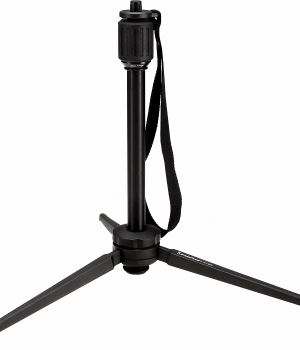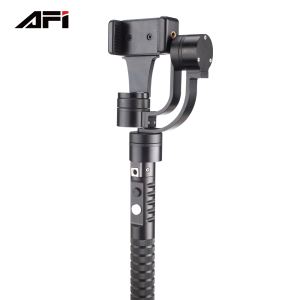Small action cameras like the GoPro5/ GoPro4/ GoPro3+/ GoPro3 are a great choice for versatile on-the-go film making. If you ever used a GoPro before then you know first hand that getting quality stable video can be a huge challenge especially when your trying to accomplish movings shots such as capturing first person view or shooting from a moving platform like a truck or a motorcycle.

A handheld gimbal for your GoPro will not only drastically improve the smoothness of your shots but it will also allow you to get much more usable footage which overall will improve your videos and capture your audience's attention!

Stabilizing the GoPro is best accomplished with a 3 axis type of gimbal. Rather than a 2 axis gimbal, which only stabilizes the horizon and tilt of the camera, a 3 axis gimbal adds panning stability (yaw) which significantly improves the left to right frame motion giving your footage a more "cinematic" shooting style. The addition of the yaw stabilization also helps tone down the "rolling shutter" effect that the GoPro tends to have and will help eliminate harsh left to right jarring while filming.
Handheld gimbals are by far the most popular form factor of a GoPro gimbal. The single handle and small size allows for one handed operation and allows you to film from tigher angles. For skilled shooters looking for dynamic action shots you can use the gimbal while riding a bicycle, skateboard or even rollerblades to capture some really great footage.
Here we introduce a hot 3-Axis Handheld Gimbal A5 for GoPro sport cameras.
The A5 3-Axis Handheld Gimbal allows you capture stabilized, pro-quality video with your GoPro camera. It works with all GoPro5/ GoPro4/ GoPro3+/ GoPro3 cameras and is also compatible with other similar size action cameras.
The high torque, precision wound brushless motors coupled with high frequency 200 Hz position encoders ensure high stabilization performance even in the most demanding conditions.
The A5 stabilizer for cameras selfie stick is plug & play ready for you to use out of the box without any complex setup or software configuration. You can switch between 4 operating modes with a simple click of the mode button located on the handle. The operating modes allow you to quickly lock the camera on the pan, tilt, and roll axis, or smoothly follow your hand motions as you pan and tilt the handle.

You can also use A5 upside down for low inverted shots or manually control the tilt of the camera by using the Up/Down toggle buttons on the handle. It is powered by four rechargeable high-capacity 3600mAh Li-ion batteries which can also be used to supplement the power to your GoPro camera using the included charging cable. The blue battery indicator light on the handle monitors the remaining battery life letting you know when it is time to recharge the batteries.

The Inverted mode allows you to use your gimbal upside down. You must be in Heading & Tilt Follow mode first before you turn the gimbal upside down. This mode is an inverted version of the Heading & Tilt mode. You can also lock the tilt in inverted mode by entering into Heading Follow (1 click). Before returning the gimbal back upright, ensure you select the Heading and Tilt follow mode first.

Features:
No complex setup
Can charge the GoPro camera with the included charging cable
Up to 7 hours of extended battery life
Compatible with GoPro LCD BacPac or Battery BacPac accessories
Heading Follow, Heading Lock, Heading & Tilt Follow, and Invert modes
Supports remote operation via remote extension (sold separately)
Manual tilt control and single button operon

2.Gimbals for Small and Large DSLR Cameras
Both mirrored and mirror-less DSLR cameras have become very popular for shooting video. Their compact size, interchangeable lenses and improved sensor design allow for greater mobility while netting very high quality imaging. There are many different gimbals designed around DSLR cameras, some gimbals on the market are actually designed for specific cameras but most dslr gimbals are adjustable for different types of cameras and lenses up to a certain weight and overall dimension.
The stabilization technology for these larger gimbals (and smaller gimbals) have evolved immensely in the last couple years from single IMU sensor based stabilization to a combination of blended position encoders, multiple IMU sensors and even the addition of GPS stabilization. The AFI VS-3SD is an example of this evolution being one of the first "pro-consumer" gimbals to come to market for a large range of smaller DSLR type cameras. 

This year for 2017, there will be many more options coming to market for the DSLR and mini-DSLR market. Depending on your application and intended use you are going to see more versatility come from these types of gimbals including the ability to interchange the gimbal between multiple platforms such as boom "AFI" cranes, cables cams and even small to large multirotors (drones).
3.SmartPhone Gimbals
One of the more exciting types of gimbals to recently come to market are designed to stabilize your common iPhone or Android device. Smartphone gimbals are very new to the consumer market but are so far proving to be a really big hit because of the ease of use to capture, edit and share video on the fly with your smartphone. Some smartphone gimbals such as the SteadyFone3 from Bestablecam can not only handle your phone, but can also be used with accessory mounts to stabilize your GoPro camera as well.
Smartphone gimbals are great for adding that 'cinematic' like effect to your smartphone video footage. Easy to use and very portable, these types of gimbals are great for not only families but also professionals on the go. These are great for shooting basic video such as realestate walk throughs or any type of venue tour.
Have a family member that is a cell phone video buff, but can't keep the camera still for the life of them? Well a smartphone gimbal is the perfect solution for them and also makes a great gift. Aspiring film makers can truly create remarkable shots with these gimbals.
AFI Aluminum Hand-held Gimbal V2 is the best choice for mobile smart phone.

4.How to Create Panning Time Lapses with GoPros, DSLRs or Smartphones
You’ve probably seen videos like the one above that combine timelapse photography with a smooth pan, which creates a really cool effect. You may have even wondered to yourself, “how do you make a panoramic time-lapse video?” Years ago it was quite difficult to make these panning time lapse videos but today several special tools allow us to shoot these videos quite easily and cheaply. These panning timelapse videos can be shot with either GoPro cameras or DSLRs in timelapse mode and turn out well. Here are some of the best tools to create a panoramic timelapse video:
360 degree Rotating Panoramic head for camera phone Time Lapse Camera Mount AFI MRP01
The Mini Panorama Selfie Robot is a treasure. It includes a panorama ball head, gopro mount adapter, phone clip holder, remote control, all together provides you most convenient and varied ways of shooting. As remote control has blue tooth compatible with most smartphone system, you can shoot at even 2-arms distance with a press. Small and lightweight to carry, you will be surprised!
Features:
360 degrees panorama eyeball head with Wireless Panorama Head Remote
, perfect for panorama shooting
Compatible for IOS and Android system
10 second time-lapse photography
1/4" universal screw
Come with adjustable phone holder and adapter mout
Compatible with GoPro/action cameras
Smart phone and cameras
Compact and portable
Easy to use
Can be used alone or on tripods or sliders
Useful for panorama shooting and time sliders

Factors to consider when choosing a panning tripod head for timelapse
Supportable weight: If you’re planning to use your new panning timelapse timer with just a GoPro then you probably won’t have any concerns about weight. But if you’re planning to use it with a larger DSLR camera you’ll want to check to see how much your camera weighs (with lens attached) to make sure you’ll be in the clear. Some of these panning timelapse timers can accommodate cameras that weigh up to about 4 pounds but others have weight limits of half that.
Whether it comes with smartphone cradles: Not all models do and if you’re planning to use your phone to record timelapses, you’ll want to be sure to get a timelapse panner that comes with one.
Whether it can be attached to a tripod: In many cases you may want to mount the timelapse panner on a tripod and then the camera on top of the mount, to ensure steady shots. Make sure that whichever panning timelapse head you get has a standard screw hole in the bottom so it can be mounted on top of a tripod (each one mentioned in this article has this).
Previous: AFI MRP-01 Panorma Head
Next: How To Use A Tripod 1
Related News
- What Is The Stabilzer Key On The Ca...
- Are There Any Stabilizers For The S...
- How To Use The Three-axis Gyroscope...
- What Is A Panoramic Lens
- A Panoramic Lens Used
- Application Range/Panoramic Lens
- What Is The Name Of The Panorama?
- What Role Does A Tripod Play In SLR...
- How To Use SLR Tripod
- How To Use A Tripod 1
- AFI MRP-01 Panorma Head
- How To Stitch 360 Panorama Pictures?
- Reviewing The AFI 360-Degree Panora...
- The Travel Series: How To Shoot 360...
- A5
- MA2
- MRA01
- MRP01
- V1
- V2







